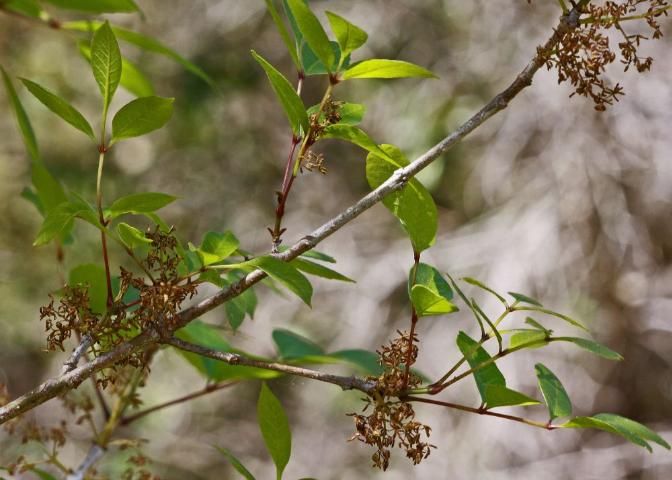Family
Oleaceae, olive family.
Genus
Fraxinus is the Latin word for the ash tree. It is also the Latin word for a lance or spear made from the wood of the ash.
Species
The species name, caroliniana, refers to the tree's origin in the Carolina region of the eastern United States.
Common Name
Pop Ash, Carolina Ash, Water Ash
The common name "Carolina ash" refers to its origin in the Carolinas (North and South). The name "water ash" refers to its affinity to wet habitats.
Description
This native deciduous tree is found in the wet soils of swamps, flatwoods, bottomlands, and riverbanks throughout the southeastern United States. It can reach heights of 30 to 50 feet and grows best in partial shade to full sun. The pinnately compound leaves are oppositely arranged and can reach a length of 4 to 10 inches. Each leaf contains 5 to 7 leaflets that are 3 to 5 inches long, are elliptical to broadly lanceolate in shape, and have coarsely serrate margins. Leaves are dark green and glabrous on the topside with a paler and glabrous to slightly hairy underside. The bark is light gray, thin, and scaly, and becomes rough and furrowed with age. While this tree may grow with a single trunk, it is often found with several crooked or leaning trunks. Flowers are 1/8 inch long and bloom in early spring before leaves emerge. The blooms appear in clusters of many yellow (male) and green (female) flowers. Fruits are 1½ to 2 inch long elliptical samaras (winged seeds) that have 1 wing (or occasionally 3). The seed itself is yellow or tan and the fruits ripen between summer and fall.

Credit: Mary Keim, CC BY-NC-SA 2.0
Allergen
The ash genus is known to be a potent allergen, producing a large amount of pollen.
Applications
Commercial/Practical
The wood of pop ash is light and weak. This, in combination with its small stature and multi-trunked growth habit, make it an undesirable tree for lumber. However, it has been used as fuel wood or collected and sent to local mills for pulpwood.
Cultural
The native American Miccosukee tribe of Florida used the stems of pop ash to make tools for grinding and pounding, and also used it as firewood. In addition, they found that the light wood of pop ash made excellent bows and arrows.
Horticultural
Pop ash has several redeeming characteristics that make it an interesting, attractive, and useful landscape tree. Its small to medium size, wide spreading crown, crooked and multi-stemmed trunk, glossy and compound leaves, and fast growth rates make it a decorative addition to landscapes. However, since it is deciduous it may not be an optimal tree to plant close to the house if shade is preferred year round. Since pop ash naturally grows in hydric ecosystems, it is best to plant this tree where adequate water is available.
Medicinal
Pop ash bark was used by the Miccosukee for what Austin (2004) calls "women's medicine."
Wildlife
Eastern tiger swallowtail butterflies (Papilio polyxenes) use ash trees as a host for their larvae.
References
Austin, D. F. 2004. Florida ethnobotany. Boca Raton, FL: CRC Press.
Borror, D. J. 1988. Dictionary of root words and combining forms (1st ed.). Mountain View, CA: Mayfield Publishing Company.
Godfrey, R. K. 1988. Trees, shrubs, and woody vines of Northern Florida and adjacent Georgia and Alabama. Athens, GA: The University of Georgia Press.
Grimm, W. C. 2002. The illustrated book of trees. Mechanicsburg, PA: Stackpole Books.
Little, E. L. 2005. National Audubon Society field guide to trees, Eastern region. New York, NY: Alfred A. Knopf.
Nelson, G. 1994. The trees of Florida: A reference and field guide. Sarasota, FL: Pineapple Press.
Ogren, T. L. 2000. Allergy-free gardening: The revolutionary guide to healthy landscaping. Berkeley, CA: Ten Speed Press.
Osorio, R. 2001. A gardener's guide to Florida's native plants. Gainesville, FL: University Press of Florida.
Kurz, H., and R. K. Godfrey. 1993. Trees of Northern Florida. Gainesville, FL: University Press of Florida.